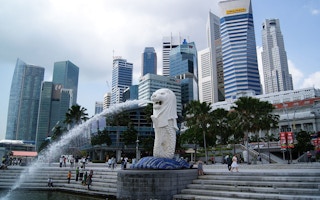Singapore has announced a steep rise in the price heavy polluters must pay for carbon emissions, as it looks to set more ambitious climate targets, in line with what scientists say is needed to battle global warming.
To continue reading, subscribe to Eco‑Business.
There's something for everyone. We offer a range of subscription plans.
- Access our stories and receive our Insights Weekly newsletter with the free EB Member plan.
- Unlock unlimited access to our content and archive with EB Circle.
- Publish your content with EB Premium.
It is also aiming to achieve net-zero carbon emissions “by or around” 2050, bringing forward an earlier commitment of reaching that target in the second half of the century “as soon as viable”.
Singapore finance minister Lawrence Wong made the announcements during the annual national budget session in Parliament, while warning that public spending on these efforts will be high for a country with limited potential to deploy renewable energy.
The cost of carbon will reach S$50-80 (US$37-60) per tonne by 2030, up from S$5 today – one of the lowest prices charged globally for carbon pollution.
The increase will be introduced in stages, starting from S$25 in 2024. Electricity bills for four-room government flats are expected to rise by about S$4 – an increase of about 4.5 per cent. The government has promised subsidies for lower-income groups.
The carbon price will rise to S$45 in 2026.
Wong said the carbon tax revenue will continue to be used in green technology investments.
“Over the coming decade, we expect to see a greening of traditional sectors of our economy like aviation, energy and tourism. At the same time, emerging green sectors like green finance and carbon services will grow in prominence,” he said.
Ajay Kumar Sanganeria, head of tax at accounting firm KPMG Singapore said that the increase in carbon tax “comes as no surprise” given the government’s 10-year green plan announced last year.
“What is good is that this change is staggered, giving businesses sufficient time to adjust and decarbonise, while minimising the impact to their business,” he added.
There was no mention of whether the criteria for who pays the tax is changing. Currently, it is levied on facilities that emit more than 25,000 tonnes of carbon dioxide yearly.
The entities that pay the carbon tax have not been made public, but the government says the scheme covers about 50 facilities in the industry, power and waste sectors, covering 80 per cent of national emissions.
In a Parliament motion last month, politicians had asked to increase the coverage of the carbon tax to those emitting 2,000 tonnes of carbon a year. There are about 200 such facilities in Singapore.
The upper limit of S$80 (US$60) for 2030 still falls short of the US$100 estimate various think-tanks have proposed to keep climate change below 2 degrees Celsius, a global target set in the landmark 2015 Paris Agreement.
Resource consultancy Wood Mackenzie had also estimated that carbon prices need to reach US$160 per tonne by 2030 to keep global warming below 1.5 degrees Celsius – a target that scientists say helps to dodge the worst effects of climate change.
Firms paying Singapore’s carbon tax will be allowed to use “high quality” international carbon credits to offset up to 5 per cent of their annual payments.
Singapore has a voluntary global carbon exchange, Climate Impact X, set up with local financial institutions. The government-backed bourse is looking to auction carbon credits this year following trials with forest protection projects in Africa, Asia and Latin America.
The government also announced a “transition framework” that will help defray costs for emitters, tagged to efficiency standards and decarbonisation targets.
“This will help mitigate the impact on business costs while still encouraging decarbonisation,” said Wong.
Climate ambition
The finance minister said Singapore was on-track to reach its target of peak emissions by 2030.
The country could bring forward its net-zero targets because international carbon markets and green technologies have become more developed, he added.
Singapore is eyeing carbon capture and hydrogen fuel to help decarbonise its large power and chemicals industry. It awarded S$55 million last year to 12 research projects in these areas, involving large petrochemical firms and local research centres.
“We aim to move Singapore into the forefront of green technologies, where new innovations are developed, trialled, scaled up and eventually exported to the rest of the world. We will work hard to grab first-mover advantage,” Wong said.
Other measures announced include the issuance of S$35 billion of green bonds by 2030 to fund public sector projects. Such bonds have been used to finance a waste and water treatment facility in Singapore.
The government is also looking to further boost the adoption of electric vehicles. It already has a target of phasing out cars that run only on fossil fuels by 2040, and aims to install 60,000 electric car charging points by 2030.
More details on the measures announced are expected in the coming weeks, as the government debates the details of how it intends to spend money in the financial year ahead.
“The climate measures announced today during the Budget are a step in the right direction,” said Isaac Neo, spokesperson for advocacy group Singapore Climate Rally.
“However, there was no update to the 2030 target, which is also important as cutting emissions earlier rather than later will mitigate more warming,” Neo added. The Intergovernmental Panel on Climate Change had said global emissions need to be halved by 2030.
“High income countries like Singapore should achieve these goals even earlier to give low income countries more time to transition,” Neo added.








